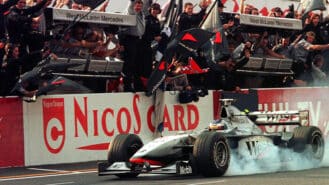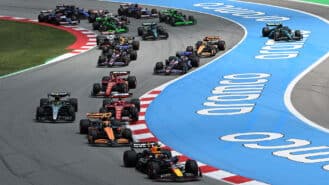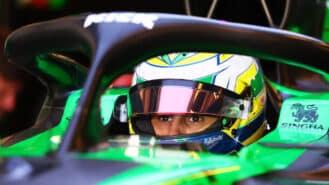After Red Bull’s 2017 F1 troubles, the manufacturer’s RB14 is a significant step away from the RB13

Red Bull’s relatively early car launch is very much against team tradition. With its Monday reveal, Red Bull is giving the impression that its eager to get miles on the car, not only to establish reliability but also to find out if its concept works as promised in simulations. This is for two reasons. One, last year’s car didn’t work as promised, and two, the RB14 is actually quite different in concept to the RB13.
The RB14 is markedly less ‘naked’ around the area ahead of the bargeboards than the RB13 was at launch. That car subsequently grew more guide vanes and bodywork add-ons in that area as the 2017 season progressed – and it ended up with arguably the best low-medium speed corner performance of all, but it had taken half a season to get it there. In hindsight the RB13’s original naked form was the visual giveaway that something wasn’t quite right in the car’s conception.
It turned out that the wider tunnel model (representing the wider 2017 regulation car) corrupted the numbers by its closer proximity to the tunnel walls. Based on those numbers, in the first year of the new bodywork regulations, the team pitched its drag-downforce trade-off at the lower-drag end of the spectrum compared to Mercedes and Ferrari. The inference was the tunnel numbers exaggerated the drag of the RB13 and so more downforce than necessary was sacrificed. The car began the year around 1.5sec off the pace of those cars – with the troubled Renault engine responsible for only a third of that deficit. Aerodynamically, it could not generate good downforce at the front and rear simultaneously until the various vanes and add-ons came later in the season.
However, despite the enhanced priority of downforce in the RB13’s development, some of the key features visible on the RB14 suggest that low drag has been given renewed attention. The team may have pursued this direction in the expectation of a horsepower shortfall…
Related:
The most striking aspect of the car’s bodywork is that the sidepods do not appear to be of the full permitted width. They are extremely narrow, leaving a far bigger channel of floor area outside of them. The inlets themselves are unusually small as a result – and this would imply an expanded radiator outlet area at the rear to give the required throughflow of air, though the official photos don’t reveal this. Not having the sidepods take up the full width permitted would make for less of a ‘coke bottle’ profile as the bodywork sweeps inwards towards the back of the car, as would the presence of a bigger radiator outlet there. This implies less acceleration of the airflow in that area and therefore less downforce, in the interests of lower drag from the smaller frontal area of the narrower sidepods.
The car’s nose is significantly slimmer than before, again fitting with the low-drag concept. It appears to be structurally multi-contoured in order to get the required combination of slimness with crash test worthiness.
Last year’s Red Bull was the equal shortest in wheelbase (with the Toro Rosso), shorter, even, than the Ferrari. As traditional with Red Bulls, it relied heavily upon an extreme degree of rake to create good underbody downforce. The amount of downforce generated by the underbody will be a multiple of the speed of airflow and the area of the floor. By going for a short wheelbase the team was limiting the floor area – helping keep the car beneath the minimum weight limit, pre-ballast – and therefore surrendering some downforce, relying on the ability to run more rake than everyone else (and therefore maximising the airflow speed) to compensate. It is not clear if this short wheelbase has been retained on the RB14. It doesn’t appear to be a long wheelbase car in the way of last year’s Mercedes, but there may have been some lengthening in an attempt at clawing downforce back lost to the low drag concept.
The front wing appears much like the one that raced on the RB13 (and may even be that same wing), with the multiple elements extending further inwards than on most cars. This would make for a more benign, less aerodynamically sensitive car albeit at some cost of impeding the flow to the leading edge of the floor (again probably relying on how sympathetic its rear end aerodynamics are to high rake).
Far from being the expected slight tweak to last year’s car, the RB14 appears to represent a re-assessment of priorities.





